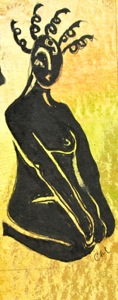My sequel to the pursuit of happyness
I realise that despite
planting berries,
I expect mangoes on the
tree of my life
and I whip myself for not following
my dotted lines. But now I have made
a resolution of making no resolution.
I don't wish to lose weight— I take walks
and sit in Vajarasana because I like to.
I don't wish to be the lead Guitarist
of any Band; I just wish to strum
and hum songs because I enjoy it.
I have given up smoking; that was
easy as I had never taken it up.
I make Debit/Credit entries to fulfil,
satiate and yet challenge myself.
I poeticize the mundane and that
gives me an intense mental orgasm.
I do not use a Planner, no checklists,
no milestones, no alarms!
On deeply looking into the mirror,
it has dawned upon me that my right eye
is smaller than the left one and my dark
circles have become darker. One thing I strive
for is to get ample sleep as I vouch
that the foundation of a good day
is the rest which I get the previous night.
And Yes, growing a beard is certainly
a sign of my new found freedom—
and maybe a little lethargy.
and I whip myself for not following
my dotted lines. But now I have made
a resolution of making no resolution.
I don't wish to lose weight— I take walks
and sit in Vajarasana because I like to.
I don't wish to be the lead Guitarist
of any Band; I just wish to strum
and hum songs because I enjoy it.
I have given up smoking; that was
easy as I had never taken it up.
I make Debit/Credit entries to fulfil,
satiate and yet challenge myself.
I poeticize the mundane and that
gives me an intense mental orgasm.
I do not use a Planner, no checklists,
no milestones, no alarms!
On deeply looking into the mirror,
it has dawned upon me that my right eye
is smaller than the left one and my dark
circles have become darker. One thing I strive
for is to get ample sleep as I vouch
that the foundation of a good day
is the rest which I get the previous night.
And Yes, growing a beard is certainly
a sign of my new found freedom—
and maybe a little lethargy.

Vajarasana -- Catherine Maunsell

Chris Gardner (co-written with Quincy Troupe) published "The Pursuit of Happyness," his autobiographagical story of his rise from homelessness to successful stockbroker. Steven Conrad adapted the book for a 2006 film directed by Gabriele Muccino. The title (derived from Thomas Jefferson's list of "Life, Liberty, and the pursuit of Happiness" as humanity's "unalienable Rights") was based on a misspelled sign at a daycare facility.
ReplyDeleteVajrasana (the Thunderbolt pose) is a kneeling asana (physical posture) in hatha yoga ("hatha' is Sanskrit for "force" and alludes to a system of physical techniques). In its modern form, the practitioner sits on the heels with the calves beneath the thighs; there is a 4-finger gap between the kneecaps, and the 1st toe of both feet touch each other. However, in the 17th century the term denoted sitting with the feet beside the butt, and in the 15th century the heels pressed the root of the penis (this its reference to the vajra, a club with a ribbed spherical head used by the rain deity Indra to kill sinners and ignorant people. It was made from the spine of the sage Dadhichi, the personification of drought, so that Indra could defeat a usurping snake deity and reclaim heaven). In tantric Buddhism, the vajra is a masculine symbol for the nature of reality, indicating endless creativity, potency, and skillful activity.